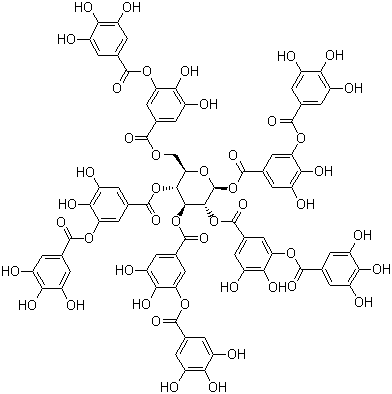Home > Offer to Sell > Intermediates > Pharmaceutical intermediates > Factory Direct Sale Tannic Acid CAS 1401-55-4 (jerryzhang001@chembj.com)
Factory Direct Sale Tannic Acid CAS 1401-55-4 (jerryzhang001@chembj.com)
Inquiry
| Post Date: | Mar 24,2017 |
| Expiry Date: | Sep 20,2017 |
| Detailed Description: |
Cas No. :1401-55-4
Factory Direct Sale Tannic Acid CAS 1401-55-4
Product Name: Tannic acid; Synonyms: TERRI PODS GALLOTANNIN;abcolgambier;abcolmimosame;abcolquebracho;abcolsumack19;abcoltannicacidtech;abcoltannicacidusp/kosher;acaciamollissimatannin; CAS: 1401-55-4; MF: C76H52O46; MW: 1701.2; EINECS: 215-753-2; Product Categories: Catechins & Tannins;Plant Extract;Food additive and acidulant;Inhibitors; Melting point: 218 °C(lit.); FEMA: 3042; Fp: 198°C; Water Solubility: 250 g/L (20 ºC); HS Code: 32019090; Description: Tannic acid has its structure still remain unclear, and is generally considered to be the ester formed by the five hydroxyl groups of glucose and gallic acid acyl group. The industrial tannic aicd can be obtained by the extraction of Gallic and further concentration. After further purification, we can obtain pharmaceutical or reagent tannic acid. Tannic acid is a pale yellow amorphous powder or shiny scaly-like or sponge-like solid. It has no special smell with bitter taste and convergence. It can be gradually darken upon exposure to air and sunlight. It is soluble in cold water and even infinitely soluble in hot water; it is also soluble in methanol, ethanol, acetone and ethyl acetate but insoluble in benzene, ether, chloroform, petroleum ether and carbon disulfide. The aqueous solution of tannic acid exhibits weak acidic and is easily oxidized with oxidation rate being faster in alkaline solution and the color of the solution being deeper. In coming across trivalent iron ions, the solution exhibits blue-black color and can react with gelatin, alkaloids to generate precipitate. It can also react with metal ions such as lead, aluminum, and zinc to generate poly-nuclear complexes and insoluble salts with special colors. When being heated to 210 ~ 215 ℃, tannic acid can be decomposed into pyrogallic acid and CO2. Tannic acid has low toxicity, but high intake of it can cause vomiting, abdominal pain, diarrhea, and can also lead to circulatory system disorder which is lethal, LD100 6.0 g/kg (rat, orally). At high temperature, it can be decomposed to generate pyrogallol and carbon dioxide. Market selling tannic acid usually contains 10% moisture. Usage: It is suitable for tanning harness leather, sole leather and sheepskin. It is recommended to store it in a cool, dry, ventilated warehouse. It is better to be used in combination with other tanning agents. It is mainly used for tanning. It can also be applied to the medicine, ink, printing, rubber and metallurgical industries as well as water treatment, etc. It can be used for tanning, fishing net dyeing, boiler cleaning, drilling, etc. It can be used as analysis reagents as well as applied to the pharmaceutical industry. It can be used for the pH adjusting of pelt pickling and vegetable tanning solution. It can be used for vegetable tanning rinse. Owing to its strong acidity, we shouldn’t pack it in iron containers. It should be stored in a cool warehouse. It can be used as a water-base drilling viscosity reducer and cement retarder. In pharmaceutical industry, it can be used as the raw material for the preparation of gallic acid, pyrogallol and sulfa drugs. Tannin is a kind of hemostatic drug. In the field of medicine, it has ever been used for treating pharyngitis, tonsillitis, hemorrhoids and skin blistering disorders, internal application can curb diarrhea and intestinal hemorrhage. Tannin can react with metals, alkaloids and glycosides, etc to form precipitate with detoxification effect against these substances. Tannin can be used for leather tanning, manufacture of ink, paper and silk glue, boiler cleaning etc., it can also be used as mordent, the clarifying agent of beer and wine as well as the coagulant agent of rubber as well as reagents for the determination of beryllium, aluminum, nickel and copper. In the field of chemical production, it can be used for preparing gallic acid and gallic acid pyrophosphate. Tannin is used for dilution when dealing with the mud drilling. Mix the tannin powder in proportion with caustic soda can yield tannins alkaline solution which can reduce the shearing force of thickening mud and sticky mud, improving the flow of mud. On the contrary, if the tannin powder was added directly to the mud, due to its weak acidicity, the pH of the mud is reduced. Through the ion exchange with the clay particles, it reduces the hydration of the surface of the clay particle, leading to the formation of the network structure of the clay particles, improving the mud shearing force and viscosity. According to the provision of the GB2760-89 of China, "curing tannins" can be used for low degree wine and wine, as a clarifying agent for removing protein in its turbidity state and other suspended substances. In the food industry, it can also be used as astringent agents and crude oil deodorizer. It can be used for the precipitation and weight determination of beryllium, aluminum, gallium, indium, niobium, tantalum and zirconium. It can also be used for the colorimetric assay of copper, iron, vanadium, cerium and cobalt. It can be used as the precipitating reagents of proteins and alkaloids. It can also be used as the external indicator in the titration of lead using molybdate. The role of industry tannic acid and medicinal tannic acid Tannic acid is mainly used as dyeing mordant and also used for the preparation of gallic acid, gallic acid pyrophosphate. It can also be used for making leather tanning agents, rubber coagulant, proteins and alkaloids precipitant as well as the reagent for the determination of beryllium, aluminum, nickel, and copper. The light-yellow to light brown amorphous powder obtained by the evaporation and drying of the water extract of the gallic is the industrial tannic acid with the content of tannic acid being more than 80%. It also contains a small amount of gallic acid, m-gallic acid, tris gallic acid and pentagalloylglucose. Tannic acid has the 1, 3, 4, 6-tetra-O-galloyl-2-multi -O-galloyl-β-D-glucose as the core and is the ester formed by the combination between one glucose molecule and 8 to 9 gallic acid. Tannic acid is susceptible to acid or enzymatic hydrolysis with the hydrolyzate being gallic acid and glucose. The major applications of the industrial tannic acid are as follows: 1. As the raw material of gallic acid and gallic acid pyrophosphate. 2. Mordant. For fiber fixing or staining, as the basic dyes of salt. 3. Ore flotation agent. It can be used for the smelting of the rare metal, extracting the germanium from the dust or the lead-zinc, extraction of rare metals such as thorium, polonium from solution, and extraction of lead and cooper from chalcopyrite. 4. Conversion coating. It can be used for the surface anti-corrosion of aluminum and its alloy plate, steel, copper, and zinc. 5. Food additives such as food antioxidants, beverage clarifying agent, advanced ink and the printing ink. 6. The thinner of drilling mud. 7. It can be used as a kind of synergist. It can be applied to the synthesis of 2, 4-Diamino-5- trimethoprimam, referred as TMP or sulfa synergist. 8. Deodorant. It can be used in refrigerators, warehouses, and toilet to get rid of the ammonia odor. In addition, tannic acid may also be used for synthesis of heart disease drugs such as hexobendine and dilazep; it can also be used for the synthesis of bifendate, treatment of hepatitis B; synthesis of antimony -273; treatment of schistosomiasis. Tannic acid can inhibit the growth of bacteria and intestinal absorption of toxins. It can be used for prevention and treatment of diarrhea. Medicinal tannic acid can be directly used in beverages, frozen products, candy, ice cream, meat products; as the astringents of burn wounds; stomach hemostatic agents; prevention of infection; it can be made into tannic acid glycerol, tannic acid protein, tannic acid ointments, anti-fever agent (N- bis-amidino morpholino tannic acid), health promotion agent, insect repellents, pesticides, radiation protection agents, contraceptive agents and special-effect toothpaste. |
| CAS Registry Number: | 1401-55-4 |
| Synonyms: | ;Chinese tannin;Gallotannic acid;Gallotannin;Galloylglucose;Glycerite;Penta NM digalloyl glucose;Quebracho;Tannins;1,3,6-tris-O-(3,4,5-trihydroxybenzoyl)hexopyranose;1,2,3,4,6-pentakis-O-[(3,4-dihydroxy-5-{[(3,4,5-trihydroxyphenyl)carbonyl]oxy}phenyl)carbonyl]hexopyranose; |
| Molecular Formula: | C76H52O46 |
| Molecular Weight: | 1701.1985 |
| Molecular Structure: | 
|
| Safety Description: | S24/25:; |
| Company: | Nanjing Bangnuo Biotechnology Co., Ltd. [ China ] |
| Contact: | Jerry Zhang |
| Tel: | 86-25-52198306 |
| Fax: | 86-25-52198306 |
| Email: | jerryzhang001@chembj.com |
-
Disclaimer statement:The information and data included above have been realized by the enterprises and compiled by the staff, and are subject to change without notice to you. The Chemnet makes no warranties or representations whatsoever regarding the facticity, accuracy and validity of such information and data. In order to ensure your interest, we suggest you chose the products posted by our gold suppliers or VIP members.


